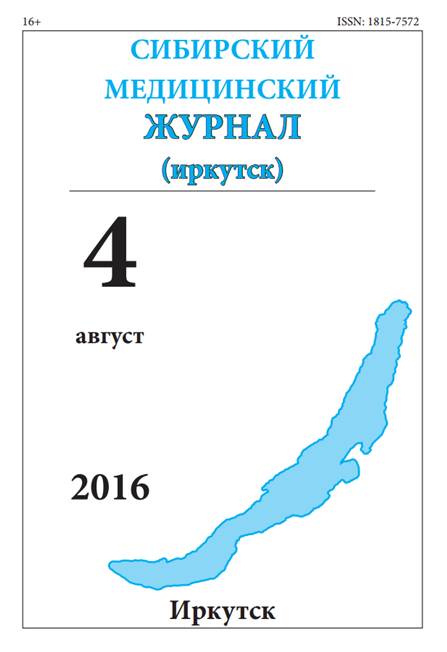СПОСОБ ОСТЕОСИНТЕЗА ХИРУРГИЧЕСКОЙ ШЕЙКИ ПЛЕЧЕВОЙ КОСТИ У ЛИЦ ПОЖИЛОГО ВОЗРАСТА
Аннотация
В данной статье авторами разработан и предложен способ лечения переломов проксимального конца плечевой кости у лиц пожилого возраста. Приведен опыт лечения 98 больных с переломами хирургической шейки плеча с использованием двубраншевого интрамедуллярного спицевого фиксатора. В послеоперационном периоде иммобилизация осуществляется гипсовой лонгетой в течение 4 недель. Результаты лечения больных с переломами проксимального отдела плечевой кости оценивали по шкале Neer C.S. Нами выявлен ряд преимуществ данного способа, а именно, малая травматичность, индивидуальный подход в изготовлении металлоконструкции, прочная фиксация отломков. Применение данной методики позволило получить в 95,9% случаев хорошие результаты лечения.
Литература
2. Воронин Н.И. Лечение высоких переломов плечевой кости. Состояние вопроса. Поиски. Решения // Проблемы физического воспитания и здоровья. – М., 1994. –192 с.
3. Ключевский В.В. Хирургия повреждений. – Ярославль, 1999. –587 с.
4. Скороглядов А.В. Применение титановых эластических стержней при остеосинтезе переломов проксимального отдела плечевой кости у подростков // Педиатрия. –2008. – Т. 87. №2. – С.134–136.
5. Bengner U. Changes in the incidence of fracture of the upper end of the humerus during a 30-year period // Clin. Orthop. –1998. – Vol.231. – P. 179–182.
6. Buecking B., Mohr J., Bockmann B. Deltoid-split or Deltopectoral Approaches for the Displaced proximal humeralfractures? // Clin. Orthop. Relat. Res. – 2014. –Vol. 472 (5). – P. 1576–1585.
7. Hessman M. H., Hansen W.S. Locked plate fixation and intramedullary nailing for proximal humerus fracture: a biomechanical evalution // J. Trauma. –2005. –Vol.58. №6. –P.1194–1201.
8. Jung W.B., Moon E.S., Kim S.K. Does medial support decrease major complications of unstable proximal humerus fractures treated with locking plate? // BMC musculoskelet. Disord. – 2013. – Vol. 14. – P.102.
9. Launonen A.P., Lepola T., Flinkkila T. Treatment of proximal humerus fractures in the elderly // Acta Ortopedica. –2015. – Vol. 86. №3. –P.280–285.
10. Lefevre Y., Journeau P., Angelliaume A. Proximal humerus fractures in children and adolescents // Orthopaedic and traumatology. –2013. –Vol. 100. №1. – P. 149–156.
11. Liu k., Liu P.C., Liu R. Advantage of minimally invasive lateral approach relative to conventional deltopectoral approach for treatment proximal humerus fractures // Med. Sci. Monit. – 2015. – Vol.21. – P. 496–504.
12. Neer C.S. Displaced proximal humeral fractures. Part I. classification and evalution // J. Bone Joint Surg. (Am). – 1970. –Vol. 52. №6. – P. 1077–1089.
13. Rangan A., Handoll H., Brealey S. Surgical vs nonsurgical treatment of adults with displaced fractures of the proximal humerus: The profher randomized clinical // JAMA. – 2015. – Vol. 313. №10. –P.1037–1047.
REFERENCES
1. Weinstein V.G., Kashkarov S.E. Treatment closed intraarticular fractures and dislocations konechnostey. – Leningrad: Meditsina, 1973. – P.39–43. (in Russian)
2. Voronin N.I. Treatment of high fracture of the humerus. Status issue. Search. Solutions // Problems of physical education and zdorovya. – Moscow, 1994. –192 p. (In Russian)
3. Klyuchevskii V.V. Surgery povrezhdeniy. – Yaroslavl, 1999. – 587 p. (in Russian)
4. Skoroglyadov A.V. The use of titanium elastic rod osteosynthesis of fractures of the proximal humerus in adolescents // Pediatriya. – 2008. – Vol.87. №2. – P.134–136. (in Russian)
5. Bengner U. Changes in the incidence of fracture of the upper end of the humerus during a 30-year period // Clin. Orthop. –1998. – Vol.231. – P.179–182.
6. Buecking B., Mohr J., Bockmann B. Deltoid-split or Deltopectoral Approaches for the Displaced proximal humeralfractures? // Clin. Orthop. Relat. Res. – 2014. –Vol. 472 (5). – P.1576–1585.
7. Hessman M. H., Hansen W.S. Locked plate fixation and intramedullary nailing for proximal humerus fracture: a biomechanical evalution // J. Trauma. – 2005. –Vol. 58. №6. –P. 1194–1201.
8. Jung W.B., Moon E.S., Kim S.K. Does medial support decrease major complications of unstable proximal humerus fractures treated with locking plate? // BMC musculoskelet. Disord. –2013. – Vol. 14. –P.102.
9. Launonen A.P., Lepola T., Flinkkila T. Treatment of proximal humerus fractures in the elderly // Acta Ortopedica. – 2015. –Vol. 86 (3). – P.280–285.
10. Lefevre Y., Journeau P., Angelliaume A. Proximal humerus fractures in children and adolescents // Orthopaedic and traumatology. – 2013. – Vol. 100. №1. –P.149–156.
11. Liu k., Liu P.C., Liu R. Advantage of minimally invasive lateral approach relative to conventional deltopectoral approach for treatment proximal humerus fractures // Med. Sci. Monit. –2015. – Vol. 21. –P.496–504.
12. Neer C.S. Displaced proximal humeral fractures. Part I. classification and evalution // J. Bone Joint Surg. (Am). – 1970. –Vol. 52 (6). –P. 1077–1089.
13. Rangan A., Handoll H., Brealey S. Surgical vs nonsurgical treatment of adults with displaced fractures of the proximal humerus: The profher randomized clinical // JAMA. –2015. –Vol. 313 (10). –P.1037–1047.



